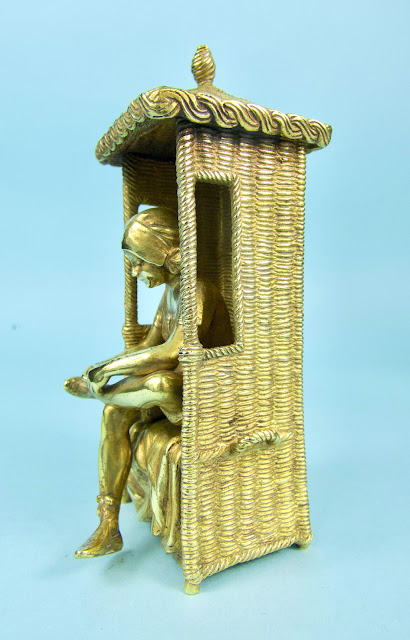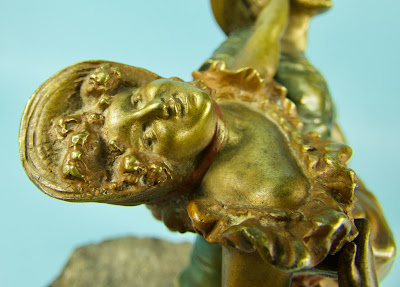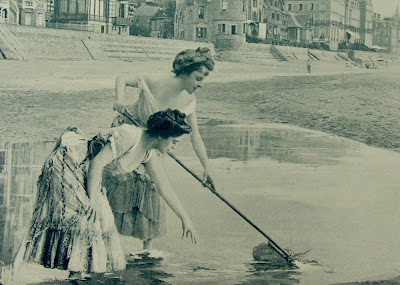The Hertwig catalog page has been updated and expanded!
Postcard Image

Thursday, December 30, 2021
Thursday, December 16, 2021
In the Hood
Thursday, December 9, 2021
Friday, November 12, 2021
Thursday, November 11, 2021
Beach Babe
The chair, which actually folds, is another example of Hertwig's imaginative use of a pennyworth (or perhaps more correctly pfennigworth) of material to make its merchandise more marketable. A few slats of lightweight wood and a thin strip of colorful material create a cunning toy chair that certainly would appeal to little girls, yet be inexpensive enough so that most parents could afford to be indulgent. Typically, Hertwig produced boy and girl pairs, so perhaps she has a male counterpart in his own little lounge. I could envision a display of these diminutive dolls in tiny chairs at some beachside or boardwalk souvenir shop.
Wednesday, November 3, 2021
Wednesday, October 27, 2021
Bad Doggy!
Friday, October 15, 2021
Thursday, October 14, 2021
Basket (Chair) Case
It releases a latch, so that the front swings open, revealing that the lovely lass remembered to bring her bathing slippers, but forget to pack the rest of her swimwear. The 7.5 inch-tall mechanical bronze sculpture is softly patinated in several delicate shades. The curtains are a greenish gold and the drapery framing the top edge of the chair is a pale rose. The bare bather's hair, styled in a wavy chignon, and her bathing slippers, tied at the ankle, have a pinkish-gold patina, while her body is a soft gold. She sits on a reddish cushion with golden trim.
Thursday, October 7, 2021
More from the Hertwig Catalog
I have added more pictures of pages and text from the original Hertwig and Company catalog, including the first appearance of badedame (bathing lady).
Thursday, September 30, 2021
I recently acquired an original Hertwig and Company catalog from the 1920s to 30s. I plan to post the entire catalog on this blog, but at some 50 pages, it may take a while.
Yet Another Toothpick Tootsie
Friday, August 27, 2021
Picture Perfect
Saturday, August 14, 2021
Shell Game
Thursday, August 5, 2021
Not So Lucky Cat?
Saturday, July 31, 2021
Going for the Bronze. . . .
I had put off posting because I was traveling with a friend to the United Federation of Doll Club's (UFDC) annual convention in Baltimore. Between the UFDC's sales room and the nearby Rowbear's National Doll Festival show, both featuring a bevy of the best doll dealers in the country, I had dreams of adding a number of new and unusual bathing beauties to my collection--perhaps even the ever elusive Galluba and Hofmann beach boy! I went ready to blow my carefully saved wad, but alas returned with my wad relatively intact. Lot of lovely dolls, but few bathing belles and none I did not already have example of in my collection. So, with the Olympics in full swing, this post is going for the bronze. But the golden gal is certainly is a first place contender! She sits serenely in her wicker beach chair, trying the ribbon to her ballet-style beach slipper (while displaying a well-turned ankle).
The back of the beach chair is stamped with a stylized urn containing a "B" and a cursive signature “Nam Greb.” The urn mark is of the Viennese foundry of Franz Xaver Bergmann, which produced detailed bronze sculptures from the 1860s until 1936. "Nam Greb" is reverse of Bergmann's name (minus one "n"). Some collectors assert that the Nam Greb signature was used on the foundry's more erotic or exotic subjects, but considering that these pieces also often carry the Bergmann cartouche, Bergmann was certainly not trying to hide these works' origin. This belle in a beach chair is 5 inches tall.
Thursday, July 1, 2021
We Oughtter Get Into the Water
Sunday, June 13, 2021
Come Lie With Me
Thursday, May 20, 2021
The Lady in Red
Most collectors, fellows or not, would be crazy for this lady in red in her saucy scarlet swimwear. Of excellent china and 5 inches tall, she sits insouciantly in a molded wicker beach chair.





















































